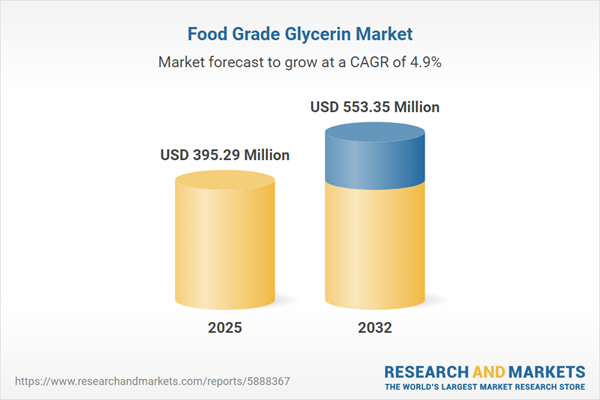Speak directly to the analyst to clarify any post sales queries you may have.
Senior leaders are re-examining ingredient transparency and compliance standards amid increased regulatory complexity in the food grade glycerin market. As organizations pursue efficient supply chain management and a stronger sustainability profile, food grade glycerin is emerging as a core enabler in meeting evolving industry expectations.
Market Snapshot: Food Grade Glycerin Market Overview and Trends
With a steady growth rate, the food grade glycerin market is strategically significant to food and beverage production. Its chemical adaptability enables manufacturers to streamline product stability and maintain regulatory compliance across a broad range of packaged food categories. Food grade glycerin also delivers key functional advantages, such as improved product texture and balanced consistency, making it a preferred choice in formulation. The trend towards clean-label manufacturing is heightening scrutiny over ingredient origins, prompting more rigorous product development processes. Additionally, evolving regulatory frameworks are driving investment in traceability tools and advanced quality assurance systems, positioning the market for further agility and adaptation.
Scope & Segmentation: Key Drivers in the Food Grade Glycerin Market
- Physical Form: Offered as both a liquid and powder, food grade glycerin enables customized formulation for various end products, supporting sectors like beverages, bakery, and processed foods.
- Purity Grade: Meeting standards such as BP, EP, JP, and USP, this versatility promotes smooth integration in food, pharmaceutical, and nutraceutical applications, enhancing operational compatibility and facilitating industry cross-collaboration.
- Application: Serving as a humectant and stabilizer, food grade glycerin is integral to bakery, dairy, confectionery, beverage production, frozen meals, and salad dressings, where moisture retention, texture maintenance, and shelf-life enhancement are needed for differentiated market offerings.
- Source: Derived from sources including animal fats, corn, palm, and soybean, this ingredient provides adaptability for allergen control, supports flexible supply sourcing, and contributes to broader sustainability initiatives amid shifting raw material landscapes.
- Geographic Coverage: The market spans the Americas, EMEA, and Asia-Pacific, with regulatory and consumer preferences, as well as technological advances, shaping sourcing decisions, compliance priorities, and collaboration models throughout each region.
- Key Companies: Industry leaders such as Archer-Daniels-Midland Company, Cargill, BASF SE, Emery Oleochemicals, Kuala Lumpur Kepong Berhad, Roquette Frères S.A., Oleon N.V., VVF, LLC, Godrej Industries Limited, and Acme-Hardesty Company continue to enhance innovation by leveraging extensive supply chain networks and applying advanced sourcing standards.
Key Takeaways for Senior Decision-Makers
- Integrating sustainable processing and new technologies has become central to addressing current regulations and achieving environmental objectives.
- Proactive regulatory and procurement strategies are essential for managing the unpredictability of global supplier dynamics, improving responsiveness to compliance updates and international trade shifts.
- Implementation of clean-label programs and ingredient traceability enhances transparency and strengthens product positioning for brands committed to quality.
- Leveraging digital traceability systems and collaborative platforms elevates supplier evaluation and risk mitigation, facilitating rapid adaptation to market changes.
- Embedding integrated quality assurance and encouraging cross-functional oversight supports compliance and solidifies productive supplier relationships.
Tariff Impact: Navigating U.S. Import Dynamics
Recent U.S. tariff measures have prompted organizations to reassess supplier portfolios and build greater sourcing resilience. Expanding regional procurement and diversifying supply bases help mitigate market disruptions and improve supply chain continuity through stronger local alliances.
Methodology & Data Sources
The findings are based on structured interviews with executive and R&D leaders, along with an extensive evaluation of regulatory documents, industry reports, patents, and proprietary analyses. A multi-step validation process ensures all insights provide actionable value for strategic planning.
Why This Report Matters
- Empowers decision-makers in procurement and compliance to align operational practices with the latest regional and global food grade glycerin standards for ongoing regulatory conformity.
- Offers segmentation tools and benchmarking that improve risk control, optimize supplier selection, and support growth-focused strategies.
- Enables rigorous due diligence for partnership development and market expansion amid a rapidly shifting industry compliance landscape.
Conclusion
This report provides clear guidance on compliance, sourcing strategies, and sustainability developments in food grade glycerin, equipping leadership to make informed decisions as market requirements evolve.
Additional Product Information:
- Purchase of this report includes 1 year online access with quarterly updates.
- This report can be updated on request. Please contact our Customer Experience team using the Ask a Question widget on our website.
Table of Contents
3. Executive Summary
4. Market Overview
7. Cumulative Impact of Artificial Intelligence 2025
Companies Mentioned
The companies profiled in this Food Grade Glycerin market report include:- Archer-Daniels-Midland Company
- Cargill, Incorporated
- BASF SE
- Emery Oleochemicals
- Kuala Lumpur Kepong Berhad
- Roquette Frères S.A.
- Oleon N.V.
- VVF, LLC
- Godrej Industries Limited
- Acme-Hardesty Company
Table Information
| Report Attribute | Details |
|---|---|
| No. of Pages | 195 |
| Published | November 2025 |
| Forecast Period | 2025 - 2032 |
| Estimated Market Value ( USD | $ 395.29 Million |
| Forecasted Market Value ( USD | $ 553.35 Million |
| Compound Annual Growth Rate | 4.9% |
| Regions Covered | Global |
| No. of Companies Mentioned | 11 |









